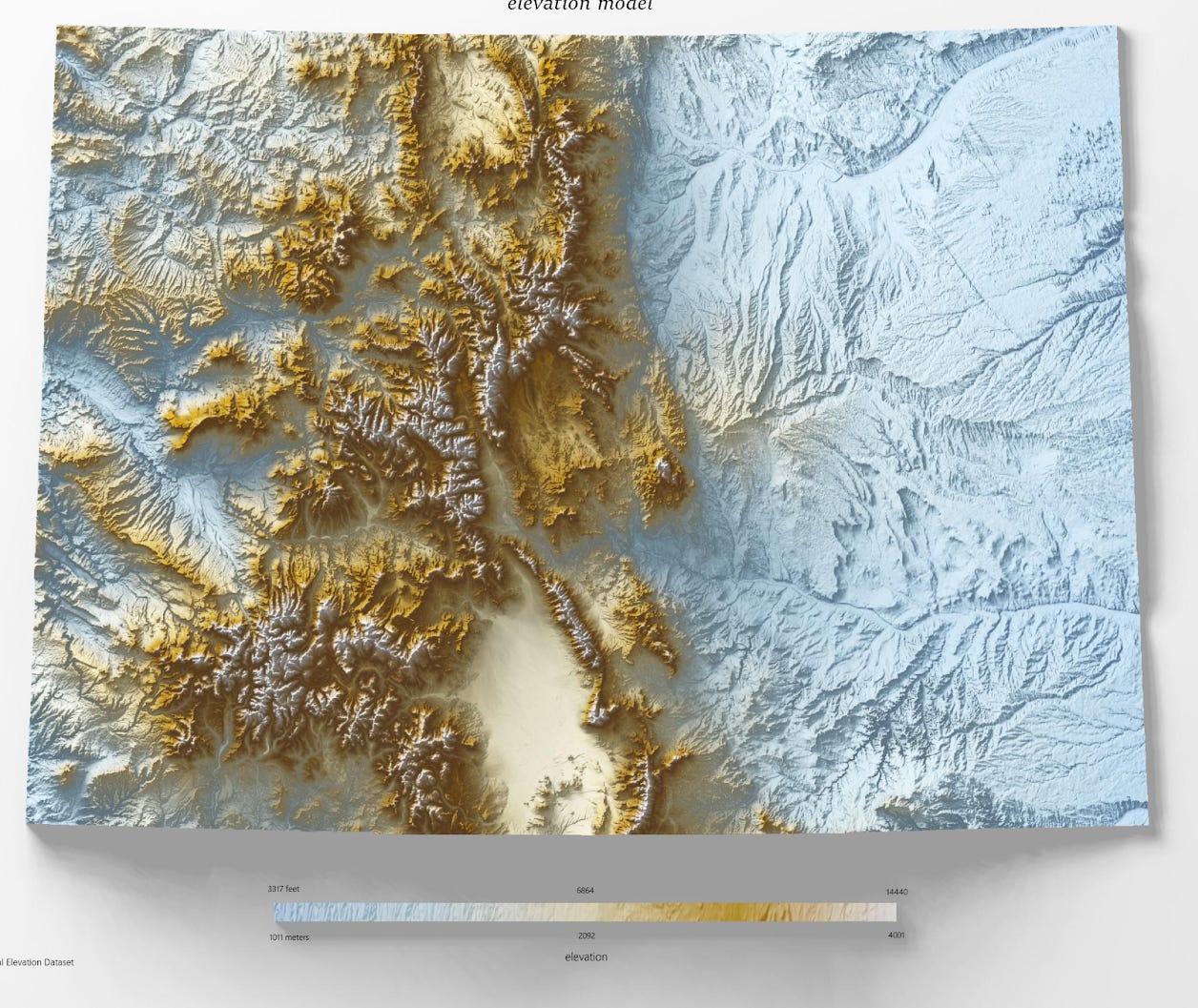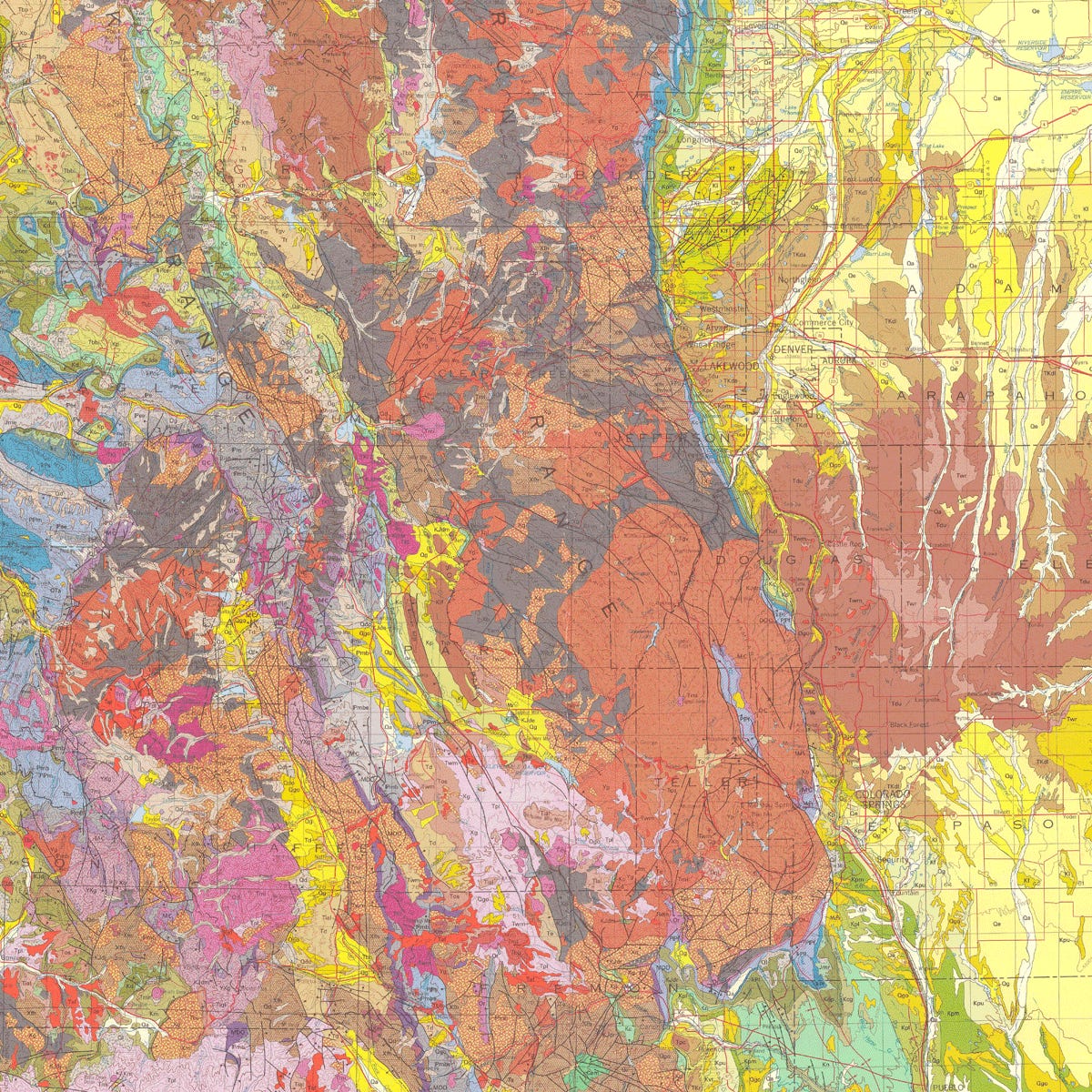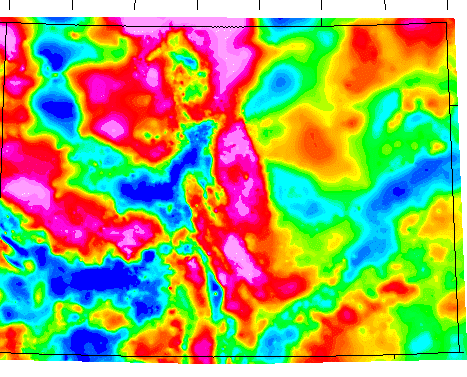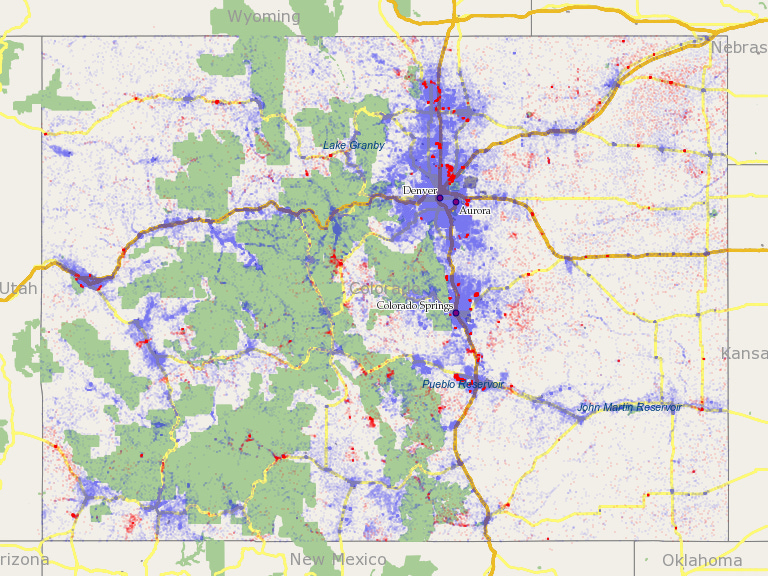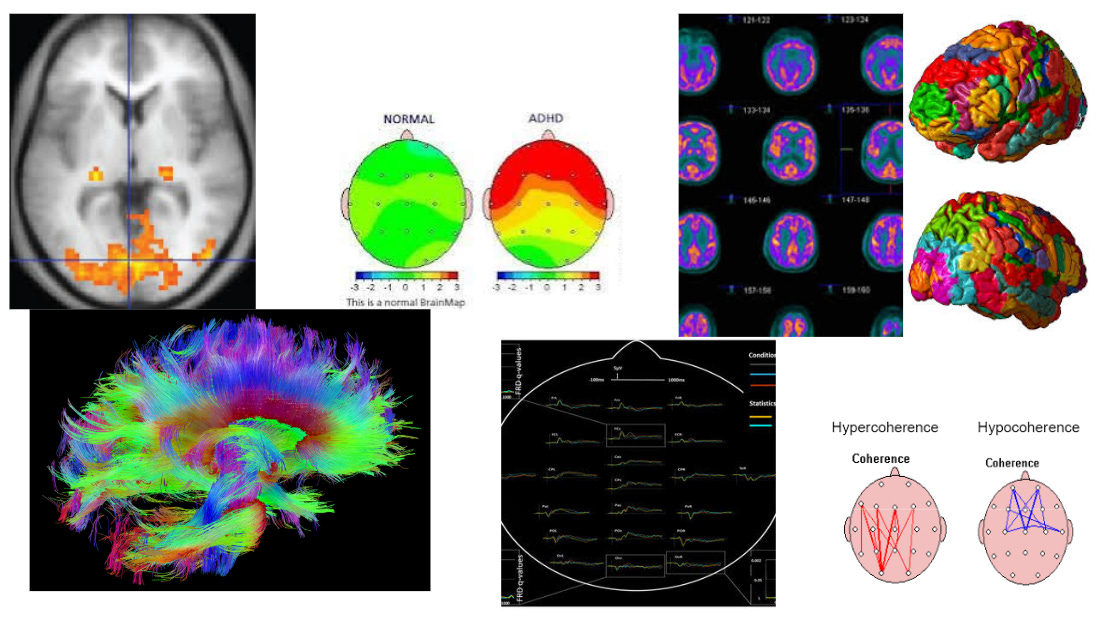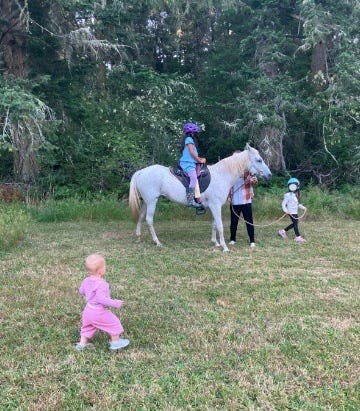We have finally made it home, and true to our expectations, nature has taken over at our little home in the desert. We pulled into our house at midnight this weekend, and could see in the headlights the Jumanji of the situation: tumbleweeds as tall as I am growing in a forest, and acreage of goatheads underfoot. The last few days have been long ones of getting the cobwebs dusted off, and of moving back into our house.
By day, these weeds are shocks of green against what is otherwise a landscape of redness. The towering cliffs have lost none of their penchant to inspire. In the short window of fresheness I always enjoy when returning from a trip, I thought I might jot down some thoughts that brewed when driving, first from a place that is mostly green and blue (the islands), then staying a long time in a place that is mostly yellow (Ellensburg), and now here, the deep red. The premise of this little blog is to share some real life experiences and some neuroscience. But the last Substack I shared didn’t mention the brain even once, so I’m afraid that today I am going to swing far over to the other side. I’ll talk mostly about the brain, but not totally the one you might expect. It is the “wider brain”, a network of cells distributed through much of the body.
And of course, I’ll add my tag that I like writing these Substacks, and in fact am doing so with the expectation that I am doing so essentially for free, at the cost of some sleep. Pieces of these writings form draft material for a book or two I’m working on, so this feels like time well spent for me. If you like what you read here, and think you know someone who might like it, I invite you to share it with them. If you are of a generous inclination, I do feel incredibly honored when readers pledge some support.
This post is exceptionally long. I am not going to apologize for that, but I would like you to know that the email may be truncated, so do feel free to follow the link to the actual Substack site if you hope to read the whole thing (and you will get kudos for making it to the end!).
In the last few days I started reading a book my dear friend gave me about how the task of writing is akin to that of a cartographer mapping out a landscape. We rarely ever need a map for a place we know well, and so as a writer we look to chart out territory that is unfamiliar, naming or describing notable landmarks and how to get between them, while also leaving significant room to explore that doesn’t, or cannot, appear on the map. When I was in college, I embarked on a 12 day backpacking trip in the Teton-Bridger Wilderness of Wyoming. Looking at the topographic map (a map showing elevations), the trail we were to follow looked like a nice smooth grade. But between the lines of the map were many small hills of less than 80 feet. They were small enough to not make it onto the map, but definitely large enough that the miles ground on and on with the significant rises and falls in elevation as we marched along.
A map can show us what is there, and it is telling of what isn’t there. In maps from the colonial era, entire continents were depicted as shorelines with blank space left for unknown regions. While Europeans salivated over what may lie in those blank spaces and virtually crawled over one another to reach them first, they missed out on the idea that there were plenty of people already living there, who in fact didn’t see their land as a blank space just biding its time until someone showed up. It was home.
The book is sparking a lot of creativity for me, and beyond the utility of the metaphor, it reminds me of how much I love a good old map. Last year I brought the idea of maps when teaching about the brain, for there are a great many ways to map the brain, just as there are of landscapes. How we map a region of interest, be it a landscape or the nervous system, and what the map shows us are very important. So too is what is left out of the map. The 80 foot hills were important for my poor feet and back, but they didn’t make the 100 foot topo map.
Let me share a few other maps, courtesy of the internet/Wikipedia:
This here is a map of the world from the 12th century, showing Europe, the Mediterranean, Africa, and a large portion of Asia. Drawn by an Arab scholar, the middle east is placed centrally on the map. It looks a bit strange to us moderns, but if you look closely, and turn the map upside down, it immediately becomes clear where Spain is, on the far righthand side. South is pointing up, so to our eyes it looks upside down, but perhaps this is how the world was thought of for navigational, trade, or spiritual purposes. It shows a very different way of looking at things.
Here is a map of a place near and dear to my heart, Colorado. It features elevations with different colors and drainages using shading, and so we can see the landscape pop out at us directly, with mountainous terrain in the western half, the giant San Luis valley south, and the plains to the east.
This is another map of Colorado. It shares some similarities, but also looks wildly different. This is a geologic map, which depicts which layers of rock are present at the surface. One of my favorite authors, Craig Childs, says that he finds geologic maps to be the most helpful when exploring the cathedrals and chasms of the Grand Canyon on foot, for it shows the rocks that are more likely to create impassible cliffs, and those more likely to erode into slopes that are navigable. One of the magical things about mountains is that the entire story of the world in the last billion years is laid out at eye level, and nowhere is this more clear than on a geologic map.
Here is again the same region, represented this time as gravity. The displacement of the Earth’s super dense mantle by the relatively less dense folds of crust underneath the mountains creates local differences of gravity’s force.
Here we finally see a more familiar depiction of Colorado, showing the state lines, roads, and population marked by the bluish purple.
Each of these maps (with the exception of the Idrisi map of the world I showed first) shows the same region, but through very different lenses. You might notice they hold some similarities. The Front Range, for example, runs through the whole state from north to south, nearly in the middle of each of the maps. The pattern of a feature of a vertical line is visible in each map, so even though each map shows very different information, they share resemblance as well.
When we discuss the brain, the same variety of maps emerges. Each are useful for different information being asked by different kinds of researchers.
There are maps related to blood circulation with fMRI and PET, there are maps of electrical and magnetic fluctuations, and there are maps related to the arrangements of cell structures (Brodmann areas). They overlap with each other in similar fashion to these landscape maps I’ve shown you, but depending on what map you look at, they also reveal hidden nuances. The fluctuations of chemistry in the brain may be helpful, but so too are the fluctuations of electricity, or the ebbing and flowing of blood pressure or heart rate. While the different maps share a lot in common, they have many diverging nuances. These nuances are important. An fMRI, for example, shows great accuracy in location. An EEG (electricity), on the other hand, shows incredible precision with the timing of activations. Both are good things to know.
We’re impacted by our maps. Many of us know about Serotonin, because we broadly still imagine that people with depression have a chemical imbalance of Serotonin. It turns out this isn’t true, but the result of this alternative fact pervading our culture means most of our existing maps of the brain include Serotonin, or often Dopamine. But how many of our maps include Large Scale Networks? Or Attachment? Not many, I would guess.
………………………………………….
Now let us turn our attention to a map of a very different sort:
Here you can see a scene unfolding from just over a year ago. We were on the lush island again, during the time when we were taking care of some young people for a friend of ours. One girl sits on a horse, one eagerly holds the lead rope. My wife is right there, minding everyone’s safety, including Blue’s (the horse). In the foreground, my daughter takes her first stumpy run in excitement. And of course, there is me behind the lens, taking this all in.
I want to ask an important mapping question about this scene:
Where is the brain?
The brain is the most unimaginably complex thing in the universe, it is where we exist, and yet we can go through life knowing so little about it. So let’s take a dive into this map.
Commonly, when we think of a brain, we think of the large, wrinkly thing located within our skull, above our ears and eyes, and say “there it is”. We also reduce the brain’s purposes down to just one of its many functions: how we think cognitively. This bit of brain is known as the cerebrum, or if we are just looking at its outermost layers, those famous wrinkly folds, we might call it the neocortex or cerebral cortex. There is no doubt it is incredibly important, this bit of brain. It is the part of humans that diverges the most from other animals in its size and morphology, and an inherent anthropocentric bias is very likely one of the major reasons why it is one of the more studied and considered parts of the brain. This cortico-centric viewpoint assumes consciousness to be cortical, and may be part of why culturally we think very little of the sentience and intelligence in other animals.
It is interesting to note that this part of the brain makes up only about 20% of the neurons that are considered brain tissue in the human brain. If we think about the total brain tissue consisting of perhaps 86 billion neurons, this leaves perhaps just 17 billion neurons in the cerebral cortex.
The vast majority of neurons in the human brain, up to 69 billion, or almost 80%, are counted in the brain’s cerebellum, the little wrinkly hindbrain. It is underresearched, to say the least, and seemingly every day the unfolding body of research about the cerebellum identifies many important functions in which this part of the brain is involved. These are often things that are traditionally associated with the cortex: memory, balance, rhythm, emotions, emotional regulation, language, planning, motor coordination, and attention. It’s worth continuing to check this out, because these discoveries are recent, and are coming out quickly.
Given the nature of these tasks, we might imagine humans to have the largest cerebellums around, but this is not so. An elephant has upwards of 250 billion neurons in its cerebellum. That’s nearly four times the amount that humans have.
These are large numbers that don’t exist concretely. Once I start saying words like “billions” the meaning is lost. But it is still crucial to get that this is a huge scale.
For example, here is the number one, written:
1
Here is 10 times that:
1111111111
And here is 10 times that:
1111111111111111111111111111111111111111111111111111111111111111111111111111111111111111111111111111
I may be a bit facetious here, but if you write out one billion 1s on sheets of paper in this fashion, my napkin math tells me it would take over 350 pounds (or almost 160 kilograms if you live somewhere sensible) of paper. That is still just one 86th of our brain’s neurons. There is a lot going on in this system.
There are several other parts of the brain to consider, and these come with important principles that make the pure brain-cell count a bit more complex.
The brainstem and particularly its upper part, the midbrain, has often been written off as a “reptillian” part of the brain, and this language is problematic because it may evoke a sense of something vestigial and outdated. But while it is possible this part of the brain may have evolved with reptiles emerging from the Permian long, long ago, it is not as if any newer elements are simply layered on top of the old. Every part of the brain to have evolved afterwards has been intricately interconnected with this part of the brain foundationally. Previously considered to be chiefly concerned with automatic functions of breath and the heartbeat, this region of the brain has increasingly been recognized as the seat of how we take in our world, how we connect with others, where attachment forms, how we experience pain, and how we sense ourselves. In short, it may be the basis of consciousness.
As someone invested in exploring how to access the brain and converse in its languages, I’ve been stymied by the location of this region. It is almost directly between the ears, nestled between the temporal lobes, girded by the cerebellum in the back, and sitting on top of the junction of the meaty neck and spine with the skull. It is so insulated from outside damage that it is also nearly impossible to reach directly with a sensor array to join a conversation of its electricity using neurofeedback. It may be so situated because of its importance with body functions, as well as consciousness, to where catastrophic damage must occur in order to impact it. The language we might use to access it would be electrical (i.e. neurofeedback) were it not for some of these factors. We must go another route, then. One in which Deep Brain Reorienting is exceptionally suited. The language of the brainstem is of sensation. Somatic awareness and the felt sense are “body-centered” but in truth are explorations of the brain in its own words.
It’s remarkable how few neurons there are in this brain region, considering how essential it is to how we feel and think. There are perhaps less than half a million neurons here, at the midbrain. And so this highlights, in addition to cell count, the importance of cell placement. This region is a crossroads between sensory input, body processes, the cerebellum, and how the cortex processes it all. A traffic light may be but a small unit with a few lights, but it is well situated to direct a semi truck to yield to a bicycle at an intersection.
There are a few other brain regions to describe. As we descend into the body, we find that there are 500 million neurons lining the tissue of the gut, referred to broadly as the enteric nervous system, our third branch of the autonomic nervous system. Compared to the billions of the cerebellum, this may not be such an impressive figure, but we may consider that this is enough neurons to form the brain of a small cat, right there in your belly.
While there might not be quite so many of these gut brain cells, these neurons, too, are well situated, and they have quite an influence. There are nine times as many connections running from the gut to the cortex (afferent) as there are running from the cortex to the gut (efferent). This suggests the gut may have quite an outsized input to the cortex, rather than the other way around. This highlights another principle for us to consider when thinking about the brain: it’s all about connections. With billions of brain cells distributed in the head and through the body, it is thought that there may be trillions of connections between them. How these connections form, and with what, matters greatly. Such growth of connections develops in utero, and continues to transform in nurturing environments. Disruptions within that environment, sometimes even subtle ones, can be impactful on how connections form.
As a fun side note, it also appears that regions of the brain behave with some quantum characteristics. While the Default Mode Network (about which I’ve written a few times and will many many more times) is closely aligned with its physical white matter connections, some networks display the co-activation of many parts that have few if any direct connections between them, showing some characteristics of quantum entanglement. Connections can leap across physical boundaries, and we’re beginning to understand that this is actively happening within the brain.
But let us return to the gut. The electrical field of these neurons is known as the Gastric Basal Rhythm. It pulses, asymmetrically, at about .05 hz, which is within a frequency band of electrical activity that I’ve been exploring in neurofeedback (I’ll describe more on this another time). The pulses of this frequency determine and coordinate (through a relationship known as phase-amplitude coupling) how the cortex produces the brain’s Alpha rhythm. The much-studied and vaunted Alpha rhythm is therefore reflective of the gut and the gut coordinates the brain as a whole. We may literally think with our gut, far more often than we give it credit for.
Let’s go a little further. Within the human body, there are about ten times as many bacteria cells as there are human cells. Almost all of these live within the gut, and we only look like humans instead of blobs of bacteria because of the size and strategic structure of our human cells.
It turns out that many of the gut bacteria can produce and release their own neurotransmitters, to be received by the gut, operating themselves as something like brain tissue.
Part of our brain then, perhaps a very large part of our brain, is not even human, but an ecosystem.
The implications and possibilities of this are enormous. For one, any time we talk about having a “gut feeling”, this isn’t simply an idiom or poetic turn of phrase. This phrase is a way of capturing a type of knowledge that is being processed in the gut part of the brain. A felt sense, an intuition. These are processes of the larger brain. It would be interesting to learn the motivations behind this part of our processing. It’s very probable that at least one part of its motivation would be to favorably maintain the ecosystem that constitutes this part of the brain. Certainly it would do this by supplying adequate nutrients and curating the ideal chemistry for the ecosystem to remain resilient. But along with consuming calories, this may mean decreasing stress, or managing one’s environment in a lot of surprising ways. It may follow that similar principles of macro-ecology related to balance and capacity apply to our gut. When out of balance, this would be reflected in the larger context of the brain, especially given the outsized influence the gut has over the cortex. We would see this manifesting as symptoms and behaviors.
One side note here is that there have been distinctive findings related to correlations of gut health and the emergence of symptoms of autism and depression. This is worth expanding on.
Another area to consider when mapping the brain is the fascia. The fascia is generally categorized into three parts: the tissue lining underneath the skin, the tissue intertwining with muscles, giving them structure, and the tissue that lines around and between organs, helping them remain in place and no doubt serving other functions. Fascia is primarily responsive to electricity, and even can generate its own. It isn’t normally considered brain tissue, from what we typically understand, but the fact of electrical responsiveness and generation lend credence to the idea of the brain-like consciousness of this particular set of tissue. Studies about the fascia are quite problematic, so I imagine that more time will pass before this set of tissue gains wider recognition as being central to many of the issues faced in mental health.
I’ll add another topic to consider. Likely anyone reading this knows that the heart beats, and pumps blood through our circulatory system. Perhaps a bit less well known is that beats are irregular, so that even if I have a steady resting heart rate of 60 beats per minute, this is actually reflecting an average beats per minute. There are fluctuations up, and fluctuations down, so my heart may be ranging between let’s say 62 and 58 beats per minute, and the flexibility of this range, and the time it takes to cycle through the highs and lows of beats per minute constitute heart rate variability. We like to have certain qualities to heart rate variability, and when we are impacted by stress, it is one of the first visible impacts of stress on the body.
The heart has a set of neurons within it. Their activity is influenced by the larger brain, and responds to all of the orienting responses, and probably gut processes that influence the wider brain. But these heart neurons have also been found to generate their own original neural activity, meaning that the heart isn’t just passively receiving signals from outside, it is effectively its own tiny little brain. It is richly interconnected with the larger brain, not wholly isolated from every other part of the system, but not passively waiting for direction either. This highlights another important brain principle: it is multipolar. A traditional unipolar lens might look like the little alien in Men In Black: a singular cortical executive pulling all the levers and pushing all the buttons that the rest of the body responds to. Instead, a multipolar view is that there are many regions within the larger brain that have a sense of the self and what’s around, and form directions and opinions that are taken into account together.
So let’s take a moment to summarize what we’ve come to so far. There are several important principles that I want to highlight before moving ahead. First, the actual cell count of neurons is very important to how much activity is occurring. Second, where those cells are located is very important, so that things like the thalamus or the midbrain may be lower in total count, but are placed such that they interface with incoming sensory information and have tremendous influence on the wider brain. Third, the connections between brain cells is important. Much of what we understand about connections comes in the form of the white matter material that literally links brain cells, but it is also found that regions of the brain have coherence on the electrical plane that are not physically connected, so we may need to reassess this at some point. Fourth, the activity of the brain is asymmetrical. Its electrical ebbs and flows come in layers of overlapping frequencies, like a symphony with extraordinarily complex harmonies, where each instrument plays an independent part. I’ll expand on this another time, when discussing electrophysiology in more depth. Fifth, the brain is multipolar. That is my way of saying this, so please take it with a massive grain of salt, but it is the only conclusion I can arrive at when considering the previous principles and the nature of where things are coordinated from. It turns out that the complex symphony is coordinated from multiple sources, including the cortex, but also the cerebellum, not least of all the midbrain, and increasing recognition has been placed on the gut and the heart in the electrical and chemical sense.
We’ve gone past 2,000 words here, and if I haven’t lost you, I’d like to jump into a sixth principle of the brain. It is the one that is probably the most important, but understanding it requires discussing the previous five principles. Thus far, the only thing I have described is the brain of a single living being, specifically, a single living human.
The sixth principle is that brain activity is shared between individuals. In our photo/map, there are five beings, including Blue the horse, plus another if you count the cameraman. Each individual is processing the sum experience of their own wider brain within their body, but there is increasing evidence of a shared nervous system experience. In writings from the 60’s and 70’s, when psychotherapy was fun, writers who had the joy of sharing observations without the burden of needing to validate them described this interpersonal space as the “field”. Field theory is still considered valid by most clinicians I’ve met, and now it is increasingly being backed up by some wild science. I’ll share a bit of that here with you.
One part of this field is that two (or more) individuals that share space with each other tend to have a phenomenon occur where their nervous systems start to resonate with one another. This field of study is known as “Autonomic Synchrony”, or “Physiological Synchrony”. Measures of the nervous system, like heart rate variability, which I described earlier, are fairly straightforward to observe. With fairly straightforward, objective data of real time heart rate variability (or skin conductance), researchers are able to notice that two people’s nervous systems start to match in the ebbs and flows of the nervous system asymmetries. It’s like two individual strings of an instrument coming into tune with each other. This doesn’t seem to be random, either. The moments of matching tend to be notable moments of togetherness. Things like empathy, cooperation, teamwork, attraction, conflict, and alarm are experienced by individuals at the precise moment their nervous systems match one another’s. It occurs across contexts, whether the individuals are strangers, lovers, family, friends, and coworkers. There is even evidence that it occurs across species, including with horses. There is evidence the effect only increases with horses the more time is spent with them, lending credence to the deepening relationship plenty of people experience.
There is a lot to say about why this occurs. It would make sense that pressures of natural selection, and the consequent survival of the most nurtured (I learned recently from Dr. Sue Johnson that this was Darwin’s actual finding, while the famous idea of “survival of the fittest” is a misunderstanding inaccurately attributed to him) enables nervous systems that come together as a diverse, organized whole that can share in safety, as well as in threat detection and defense. The fruited development of our nervous system, including sensory integration and the integrity of our sense of self, depends on a robust sense of togetherness from birth. In many ways, this is the source of much mental strife across the board, from populations with obvious developmental trauma to those who are categorized under the (odious) title of the “worried well”.
But how does synchrony happen?
There are at least two things to think about with this:
One is concerned with concrete mechanisms: We organize ourselves around how our primary senses take in the most minute details around us. Subtly, in the background, we are always picking up information - sounds reflecting off of the walls tell us if we are in a giant cathedral, a tiny slot canyon, or a bedroom, for example. If we are in a silent room, the standing waves of two walls facing each other express the frequencies and harmonics that fit neatly within the walls. If you’re interested in understanding this more, check out the recording of the musical exercise “I’m Sitting In a Room”:
A person records themself reading a script. They then play the recording on a speaker and record that. Successively each recording is played and rerecorded, and after a bit of time the only sound is the way the room captures the acoustic features of that particular room.
Beyond sound, this sensory input could include anything concerning the smallest signs, such as movements of muscle groups, changes in skin tone with circulation, and tone of voice that overlay the undercurrents of emotional processing in those around us. It seems possible that primary senses could have a huge role to play in this kind of synchronization of multiple people.
But this can happen too when two people sit next to each other in silence, so I’m going to plant a seed here that this is not the whole picture. Very hypothetically, the very concept of consciousness may be at work in coordinating multiple beings.
There is of increasing interest in the fields of neuroscience and physics surrounding the nature of Consciousness, but grabbing hold of this is a bit like when my daughter chases a bubble. The bubble floats in the air, and we delight in its impossible movements on undetected breezes. We chase it, covet it, and just at the moment that we can finally grasp it, it vanishes. It seems that the part of the self that can hold a concept like consciousness is antithetical to articulating it very concretely. It very well may be that this is related to how large scale networks and the bicameral mind work. Parts of the brain that come together for concrete, figural tasks like speaking or categorizing or writing are anticorrelated (meaning they turn off) with parts of the brain that can hold non-verbal, three-dimensional, creative, and kinesthetic processing, and vice versa.
Consciousness has a few parts to it. First is what Dr. Ed Hamlin described when we were all in Australia: Consciousness is a fundamental energy in the universe, behaving very much like other energy we study. Energy in light form has a particle function, and a wave function simultaneously. To use Dominic Walliman’s analogy, when you drop a tennis ball into a pool, that particle (the tennis ball) sends out ripples (waves) across the water. The waves ripple out continuously across the pool, until they encounter an object. In Dr. Walliman’s metaphor, the waves find a pool noodle, and right in that moment, all the ripples on the surface of the water cease to exist, and the tennis ball emerges in the pool at that exact spot the wave encountered the pool noodle.
In Quantum mechanics, this is a “Wave Function Collapse,” a moment when the quantum state, where something exists in many places simultaneously, crashes down to a single reality, and becomes real in a single place. This happens when there is an interaction with the outside world.
It has been hypothesized, and very recently reinforced, that a small structure, known as a microtubule, within all eukaryotic cells, meets the requirements of instigating a Wave Function Collapse. Such cells are in all life, and this is inclusive of the many cells of the brain.
Putting this together, consciousness may exist like a wave in the universe, resonating throughout, that we, or Blue, can tap into by virtue of the Wave Function Collapse enabled by cell microtubules. Obviously, this is a section I ought to expand on, but I would like to note and emphasize here that nothing I have written about consciousness just now is my original idea, but instead the sum of people whose brilliance I hope to kiss the feet of. (As a side note, please be very wary of the AI overview if you do a web search of consciousness and wave function collapse. It only shares some of the debate about the “Copenhagen Interpretation”, which is specifically about the mechanics of how Wave Function Collapse occurs, which is important to be sure but is not directly relevant to this discussion).
Did you make it here? I must say, I am impressed. It’s a little bit like when you get to the end of the Arlo Guthrie recording of “Alice’s Restaurant.” Just like him, I could keep going, and as he says, “I’m not proud, or tired.” But it is time to finish the song for now.
If we’re talking about multipolar, flexible, enriched nervous systems, perhaps the most complex is the one where many individuals come together. The photo I share with Blue at the center shows a moment in time, a reason, an epicenter at which six beings come together. If even for a moment, this is a magical moment.
This is, I think, what all of our conversations about AI are really missing. The Tech bros and their devotees salivate over the possibilities of AI, and that as a consequence of this technology the first person to be a trillionaire (at least since perhaps Mansa Musa) will emerge in our lifetimes, even while their fellow humans are dying of hunger. But the collective consciousness and potential for a singularity promised by the prophets of AI misses an important point: we already have the ability to do this. This isn’t a blank spot on the map, waiting to be colonized. We live here, all of us do. You don’t need to sell me sunlight. Gravity doesn’t come with a subscription fee. I breathe. And Togetherness is our birthright as beings. None of us are reliant on AI for this. Let that be what it excels at: data analysis and information transmission. Interactivity is what we already have. Why wouldn’t we deepen here?



